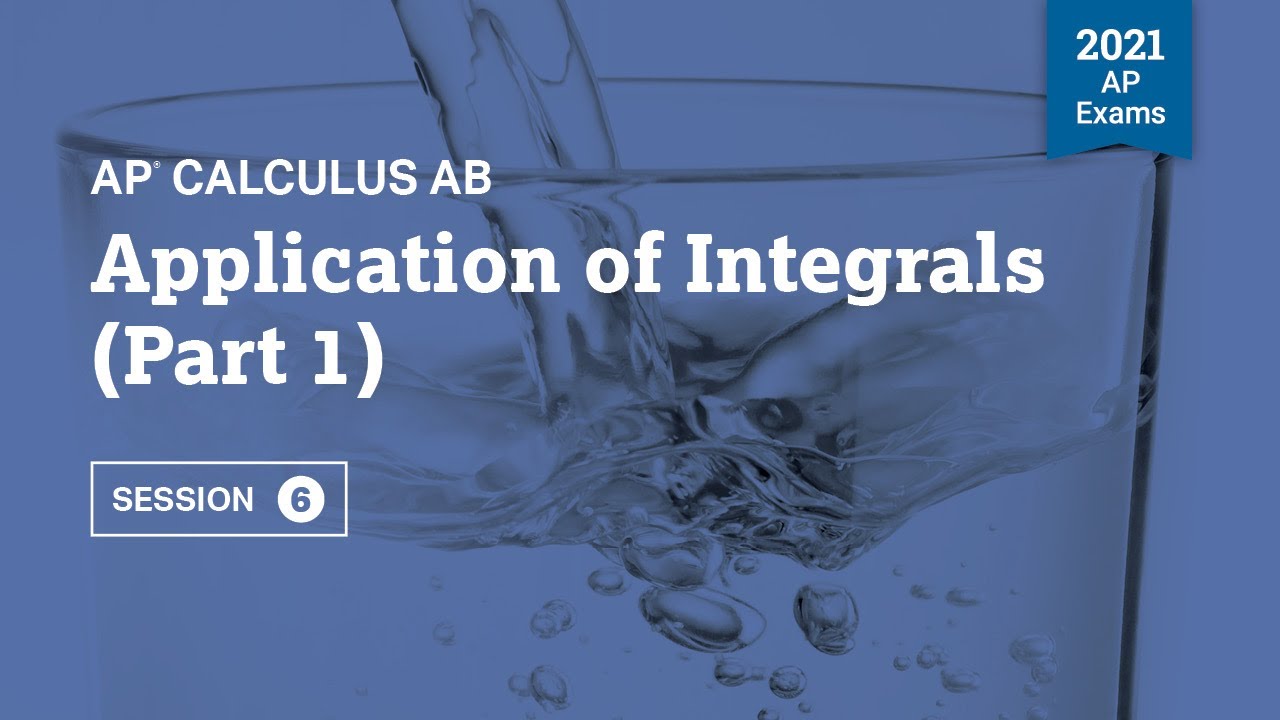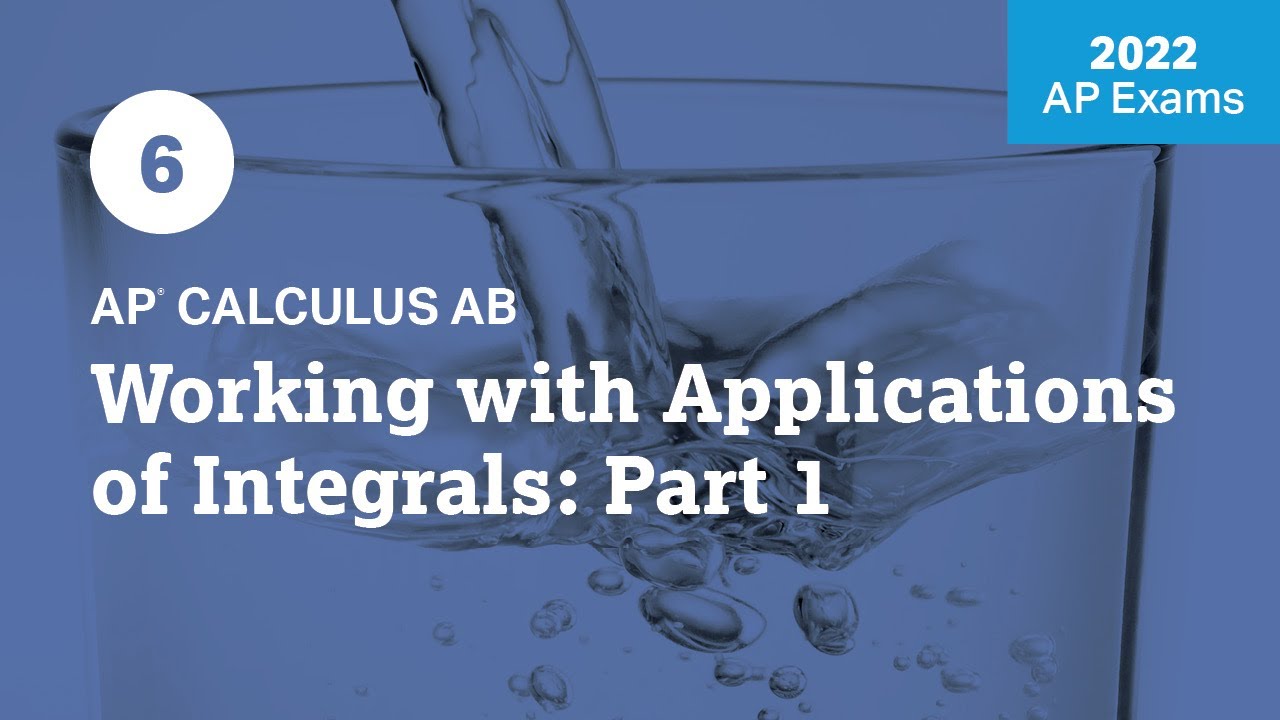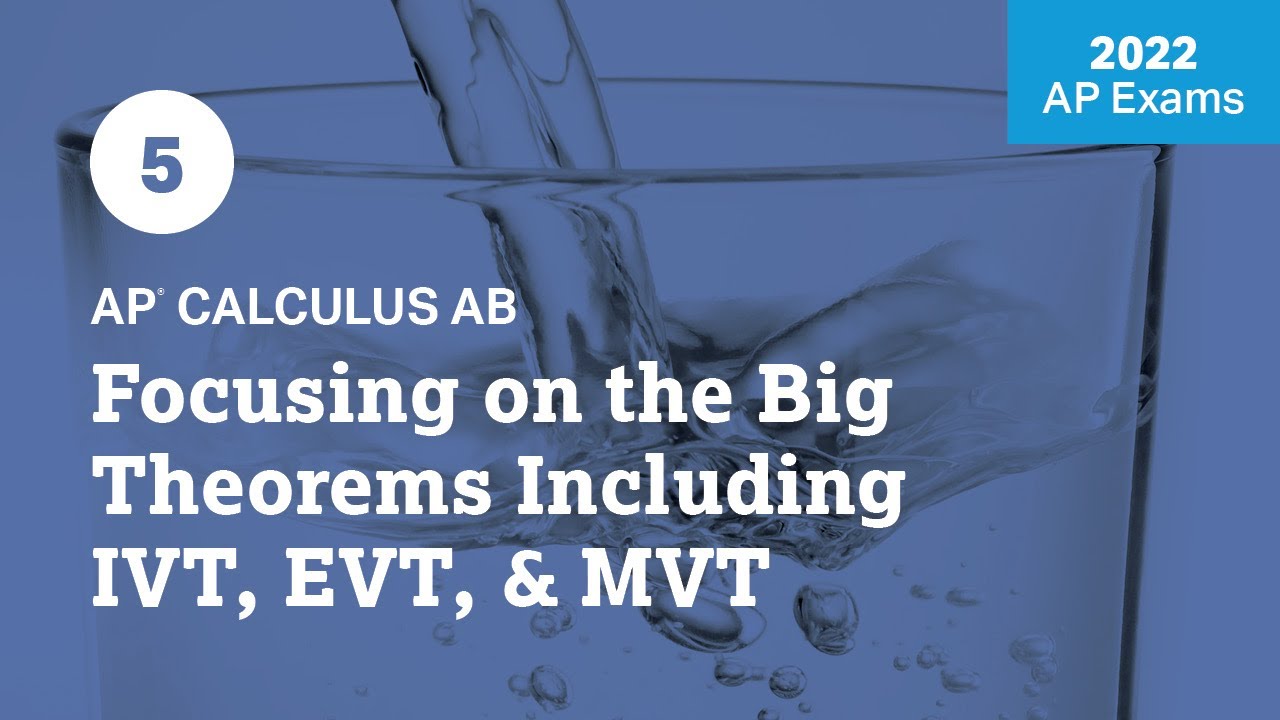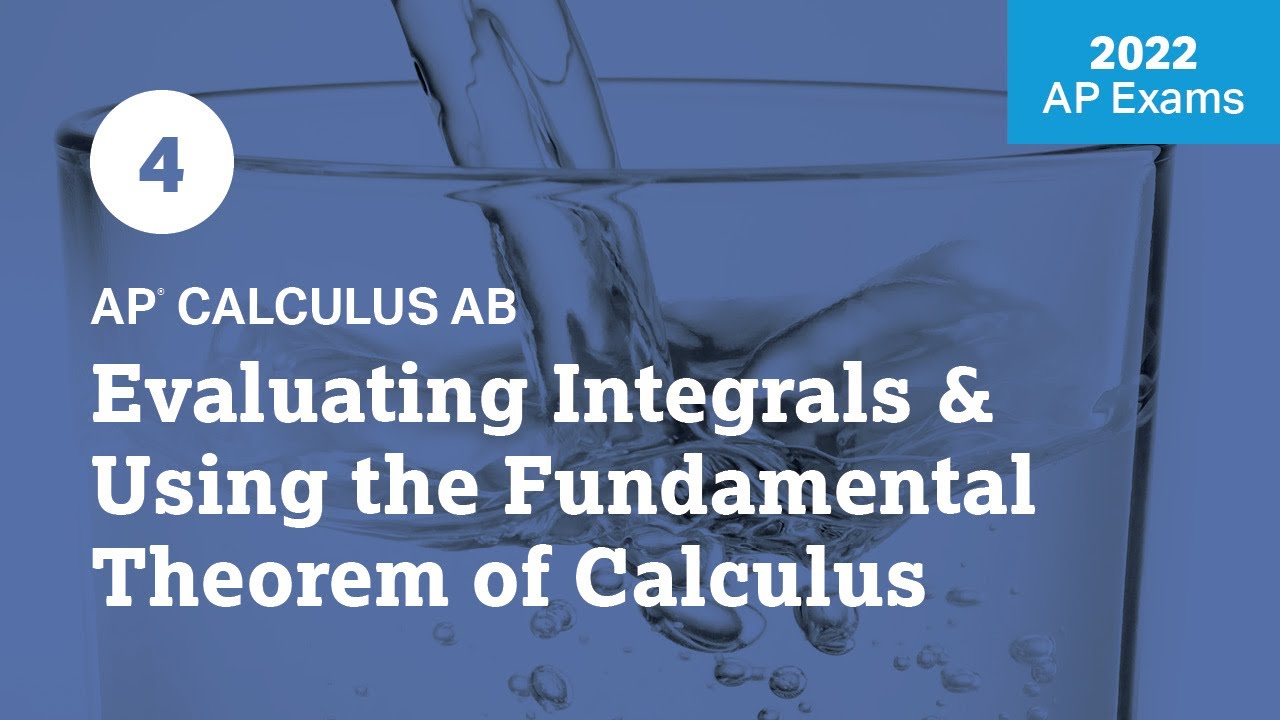2022 Live Review 7 | AP Calculus AB | Working with Applications of Integrals: Part 2
TLDRIn this educational session from a calculus series, hosts Bridge Cornelius and Mark delve into advanced topics of calculus. They focus on practical applications of integrals, discussing concepts like the area between curves and volumes of known cross-sections. The session includes problem-solving scenarios involving cylindrical tanks, chocolate ponds, and confectionary plants, emphasizing the calculation of water and chocolate volumes over time using integrals. The hosts engage in interactive teaching by solving problems, offering detailed explanations, and providing practice exercises to enhance understanding of calculus applications.
Takeaways
- 📚 The session focused on applications of integrals, specifically volumes of known cross-sections and accumulation functions, which are integral in calculus.
- 🚰 A practical problem involving a cylindrical tank was discussed to illustrate the application of calculus in calculating the change in water volume over time.
- ∫ The concept of definite integrals was used to calculate the amount of water pumped out of a tank and the amount of chocolate pumped out of a pond.
- 📈 Derivatives were utilized to determine whether the amount of chocolate in the pond was increasing or decreasing at a specific time.
- 🔢 Emphasis was placed on the importance of understanding the units and context when interpreting the results of integrals and derivatives.
- 📉 The session highlighted the use of calculators for solving integrals and derivatives, but also the necessity of understanding the underlying mathematical concepts.
- 🌀 The concept of washers and discs was introduced in the context of finding volumes when regions are revolved around different axes.
- 📏 The area under a curve, represented by the absolute value of the difference between two functions, was discussed as a method to find the net area between them.
- 📐 The importance of knowing geometric formulas for basic shapes like triangles, circles, and rectangles was stressed for calculating areas and volumes.
- 🕒 Time management was a key topic, with the instructors emphasizing the need to balance time spent on different types of problems during an exam.
- 📝 Communication in mathematics was stressed, including the need to clearly write down integrals, derivatives, and to draw diagrams to illustrate problem-solving steps.
- 🎓 The instructors encouraged consistent practice and reiterated that understanding the fundamental concepts of calculus is crucial for success in exams.
Q & A
What is the topic of the video?
-The video is a calculus lesson focusing on applications of integrals, specifically volumes of known cross sections, accumulation, and rates of change.
What is the first problem discussed in the video?
-The first problem involves calculating the amount of water in a cylindrical tank given the rate of water pumped in and released from the tank.
How is the rate of change in the tank's water level calculated?
-The rate of change is calculated by subtracting the rate of water being released from the rate of water being pumped in.
What is the significance of the integral in the context of the chocolate pond problem?
-The integral is used to calculate the total amount of chocolate pumped out of the pond over a given time period, based on a rate function.
How is the derivative used in the chocolate pond problem?
-The derivative is used to determine whether the amount of chocolate in the pond is increasing or decreasing at a specific time by analyzing the sign of the derivative at that point.
What is the purpose of setting up an integral expression for the average rate at which chocolate is pumped out of the pond?
-The integral expression helps to find the average rate by integrating the rate function over a specific time interval and then dividing by the length of that interval.
How does the concept of accumulation relate to the problems discussed in the video?
-Accumulation is the process of adding or subtracting quantities over time, which is central to calculating volumes, areas, and rates of change in the context of calculus problems presented.
What is the role of the fundamental theorem of calculus in solving the problems in the video?
-The fundamental theorem of calculus is used to convert differentiation problems into integration problems, allowing the calculation of areas under curves and volumes of solids.
Why is it important to interpret the results in the context of the problem?
-Interpreting the results provides a meaningful understanding of the quantities involved, ensuring that the mathematical solution aligns with the real-world context of the problem.
What is the significance of the intersection points in the area and volume calculations?
-Intersection points are crucial as they define the limits of integration for calculating areas under curves and volumes of solids generated by revolving regions around an axis.
How does the video emphasize the importance of clear communication in solving calculus problems?
-The video stresses the need to write down integrals, derivatives, and to draw pictures, which helps in clearly communicating the steps and thought process involved in solving the problems.
What is the final advice given to students regarding their preparation for the calculus exam?
-The final advice is to practice a little bit every day and to ensure understanding of concepts like areas, volumes, and the application of the fundamental theorem of calculus.
Outlines
😀 Introduction to Calculus Day Seven
The video begins with a warm welcome to Day Seven of a calculus series, hosted by Bridge Cornelius Lafayette from Oxford, Mississippi, and Mark from Denton, Texas. They are excited to delve into applications of integrals, focusing on areas between curves, volumes of known cross-sections, and the concept of accumulation. A warm-up problem involving a cylindrical tank's water level is presented to introduce the topic.
📚 Working Through a Chocolate Pond Problem
The hosts work through a problem involving a chocolate pond being supplied by a river and pumped out at a rate described by a function of time. They calculate the amount of chocolate pumped out over a period using definite integrals and interpret the result in the context of the problem. They also explore whether the amount of chocolate in the pond is increasing or decreasing at a specific time by taking the derivative of the function.
🧮 Setting Up and Solving Integral Expressions
The video continues with setting up, but not evaluating, an integral expression for the average rate at which chocolate was pumped out of the pond over a specific interval. They then calculate the amount of chocolate in the pond at a given time by integrating the inflow and outflow rates. The process involves using a calculator to solve the integrals and understanding the conceptual application of calculus in the problem.
🔢 Calculating the Maximum Amount of Chocolate in the Pond
The hosts determine the time interval during which the amount of chocolate in the pond is at its maximum. They use the endpoints of the interval and points where the rate of change (derivative) is zero to find potential maximums. By evaluating the function at these points and the endpoints, they identify when the chocolate amount is maximized over the given interval.
📐 Solving Area and Volume Problems
The video moves on to area and volume problems, such as finding the area of a region bounded by the y-axis and two functions. They also discuss the volume of a solid with perpendicular cross-sections to the x-axis, which are rectangles. The hosts demonstrate how to set up and compute the integrals for these geometric calculations, emphasizing the importance of understanding the cross-section shapes.
🔄 Volume of a Solid of Revolution
The hosts tackle a problem involving the volume of a solid generated by revolving a region around the y-axis. They identify the cross-sections as circular and set up the integral to calculate the volume, taking into account the need to express the radius in terms of y and to split the integral at a specific point. The process involves understanding the geometry of the cross-sections and the limits of integration.
🛠️ Washers and Area Under a Curve
The video concludes with a discussion of washers, a type of cross-section used in volume calculations when a region is revolved around the x-axis. They differentiate between the outer and inner radii of the washers and how they relate to the functions defining the region. The hosts also touch upon a multiple-choice question about finding the area under a curve defined by two intersecting functions, emphasizing the importance of understanding parent functions and the order of integration.
📈 Finding a Function Given Its Derivative
The final topic involves finding the value of a function at a specific point, given its derivative and a point on the graph of the function. They use the fundamental theorem of calculus to set up an integral that represents the change in the function over an interval and calculate the area under the derivative curve, which includes a triangle and a quarter circle. The hosts emphasize the importance of careful calculation and understanding the geometric interpretation of the derivative.
🏁 Wrapping Up the Session
In the closing segment, the hosts reflect on the topics covered, including areas, volumes, and the importance of clear communication in mathematical problem-solving. They encourage viewers to practice daily and remind them that the next session will be a mock exam. They express enthusiasm for mathematics and the engaging nature of calculus, motivating students to keep working hard for their upcoming exam.
Mindmap
Keywords
💡Integrals
💡Volumes of Known Cross Sections
💡Accumulation
💡Rate of Change
💡Definite Integral
💡Free Response Question
💡Average Rate
💡Maximum and Minimum Values
💡Solids of Revolution
💡Cross-Sections
💡Derivatives
Highlights
The session begins with an introduction to Day 7 of a calculus course focusing on applications of integrals, specifically volumes of known cross sections.
The instructors, Bridge Cornelius and Mark, discuss the concept of accumulation in calculus, relating it to both area and volume calculations.
A warm-up problem involving a cylindrical tank and water flow rates is presented to illustrate the application of calculus in real-world scenarios.
The concept of definite integrals is applied to determine the amount of water in the tank at a specific time, showcasing the practical use of calculus mechanics.
The use of calculators is emphasized for simplifying arithmetic operations in calculus problems, particularly when dealing with constant rates.
The session moves on to a free-response question about a confectionary plant's chocolate pond, integrating various calculus concepts to solve a multi-part problem.
The importance of correctly interpreting the units and context of a problem when calculating definite integrals is discussed.
Derivatives are used to determine whether the amount of chocolate in the pond is increasing or decreasing at a specific time.
The concept of the average rate of change is explored through an integral expression for the average rate at which chocolate is pumped out of the pond.
The total amount of chocolate in the pond at a given time is calculated using an integral to account for the inflow and outflow of chocolate.
The session touches on the calculation of maximum and minimum values of chocolate in the pond over a time interval, using derivatives to find critical points.
The topic of area under a curve is revisited with a focus on the absolute value of the difference between two functions to find the enclosed area.
The instructors provide a detailed walkthrough of setting up and solving integrals for the volume of a solid with rectangular cross-sections.
The concept of revolving a region around an axis to find the volume of a solid is introduced, with examples including both the y-axis and x-axis rotations.
The importance of understanding the geometry behind integrals, such as washers and discs, is emphasized for solving volume problems.
The session concludes with a discussion on the fundamental theorem of calculus and its application in finding antiderivatives and definite integrals.
The instructors encourage students to practice daily and provide reassurance that there is still ample time to prepare for the exam.
A reminder is given about the final session, which will include a micro mock mini exam to reinforce learning and provide additional examples.
Transcripts
Browse More Related Video

2021 Live Review 6 | AP Calculus AB | Application of Integrals (Part 1)

Applications of Integrals Review (All of AP Calculus Unit 8)

2022 Live Review 6 | AP Calculus AB | Working with Applications of Integrals: Part 1

2022 Live Review 5 | AP Calculus AB | Focusing on the Big Theorems Including IVT, EVT, & MVT

2022 Live Review 4 | AP Calculus AB | Integrals & Using the Fundamental Theorem of Calculus

5 | MCQ | Practice Sessions | AP Calculus AB
5.0 / 5 (0 votes)
Thanks for rating: